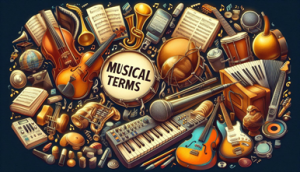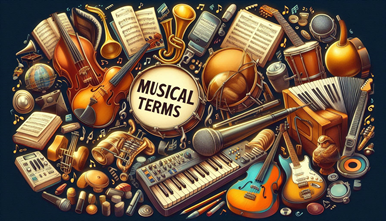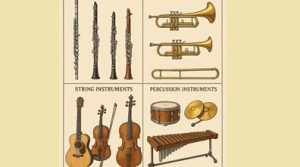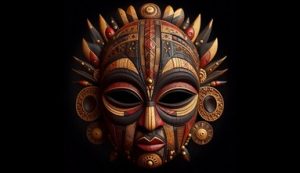Musical Terms: A Handy Guide to Essential Music Glossary
Musical Terms: A Handy Guide to Essential Music Glossary
Do you find it hard to memorize all the musical terminology? From adagio to waltz, here’s a thorough glossary of Italian musical words and other key concepts in music.

For instance, whether it’s a direction to play glissando or recognizing that Pavarotti is about to perform an aria instead of the overture, these terms are as elegant and expressive as the music they describe.
Furthermore, learning these terms can deepen your appreciation of classical music. Moreover, it can give you insight into how composers envisioned their works being performed.
In summary, here’s a breakdown of some of the most important musical terms to know:
Musical Terms that start with A
Accelerando: (Italian: “getting faster”) Gradually speeding up the tempo.
Adagio: (Italian: “slow”) Play the music at a slow tempo, as in Barber’s Adagio for Strings.
Allegro: (Italian: “lively”) Cheerful and brisk. Rossini’s William Tell Overture is a prime example.
Andante: (Italian: “walking”) A tempo marking that indicates a moderate, walking pace.
Aria: (Italian: “air”) A solo vocal piece often found in operas.
Atonal: Music without a key center, commonly used by 20th-century composers.
Musical Terms B
Ballad: A narrative piece, often imitative of folk songs.
Bar: A vertical line dividing the stave into measures.
Baritone: A male singing voice that lies between tenor and bass.
Baroque: A period in music history (1600–1750) that includes composers like Bach and Handel.
Berceuse: A lullaby, such as Chopin’s renowned piece.
Bolero: A Spanish dance, famously depicted in Ravel’s Boléro.
C
Cadence: Two chords at the end of a musical phrase, signaling resolution or continuation.
Capriccio: (Italian: “caprice”) A lively, free-form piece.
Chorale: A hymn tune, often associated with Bach.
Crescendo: (Italian: “growing”) A dynamic marking for gradually increasing volume.
D
Da Capo: (Italian: “from the beginning”) A direction to repeat from the start.
Diminuendo: (Italian: “diminishing”) Gradually decreasing in volume.
Dynamics: The variation in loudness between notes or phrases.
E
Elegy: A musical piece in the form of a lament.
Ensemble: A description of musicians playing together; refers to a group of performers.
Espressivo (Italian: “expressive”): An instruction indicating a passage should be played expressively.
Etude (French: “study”): An instrumental composition designed to improve or challenge technique, with notable examples by Chopin and Liszt.
F
Fagotto: The Italian term for the bassoon.
Flat: Represented by the ♭ symbol, indicating the note should be lowered by a semitone; also used to describe a note out of tune, sounding too low.
Forte (Italian: “strong”): A dynamic marking instructing loud playing, ranging from “f” (loud) to “fff” (very loud), with additional “f”s for extreme volume.
Fugue: A contrapuntal form where a theme is introduced and repeated at varying pitches, interwoven with other musical lines.
G
Gigue: A lively Baroque dance, originating from the English jig.
Giocoso (Italian: “playful”): Indicates a cheerful or playful style of playing.
Glissando (French: “glisser,” to slide): Sliding between a group of notes, as on a piano keyboard.
H
Harmony: The simultaneous sounding of two or more notes, often defining a composer’s “harmonic language.”
Humoresque: A piece with a humorous character, such as works by Schumann and Dvořák.
Hymn: A song of religious worship, with roots in Martin Luther’s chorales.
I
Impressionism: A late 19th/early 20th-century style in art and music, marked by rich colors and blurred imagery; associated with Debussy and Ravel, who resisted the term.
Intonation: The accuracy of pitch in singing or instrumental playing.
J
Jig: A lively English dance, often concluding a Baroque suite.
K
- Key: A musical key establishes relationships among chords, with the “tonic” serving as the sense of “home.” This central note provides a basis for tension, development, and resolution in music. The key signature, found at the start of written music, identifies the home key.
- Example: The orchestra performs Florence Price’s Symphony No. 1 in E Minor.
L
- Largo: A directive for slow, broad tempo.
- Legato: Notes played smoothly and connected.
- Leggiero: Light and gentle playing.
- (Col) Legno: For string players, using the wooden part of the bow to strike the strings.
- Leitmotif: A recurring musical phrase associated with a character, idea, or theme, often used by Wagner.
- Lento: Slow tempo.
- Libretto: The text of an opera or vocal work.
- Lied(er): German art songs by composers like Schubert and Brahms.
M
- Madrigal: Secular vocal compositions from Renaissance Italy.
- Major: A scale or key often associated with a “happy” sound, e.g., C major (C, E, G).
- Malagueña: A Spanish gypsy dance from Málaga.
- Mazurka: A traditional Polish dance, popularized by Chopin.
- Mezzo: “Half” (e.g., mezzo-forte = moderately loud; mezzo-soprano = lower female voice range).
- Minuet: A French dance from the 17th-18th centuries.
N
- Natural: A note that is neither sharp nor flat.
- Neoclassical: A 20th-century musical style incorporating Classical and Baroque structures. Composers like Stravinsky, Ravel, and Hindemith explored this style.
- Nocturne: A piece evoking a nighttime mood. Invented by John Field in the early 19th century and popularized by Chopin, who composed 21 nocturnes.
O
- Obbligato (Italian: “obligatory”): An instrumental part essential to a musical work, especially in the Baroque era.
- Octave (Latin: “octavus,” eighth): The interval spanning eight notes, e.g., C to C or D to D.
- Octet: A composition written for eight performers.
- Ondes Martenot (French: “Martenot waves”): An electronic instrument created by Maurice Martenot in 1928, famously used in Messiaen’s Turangalîla-Symphonie.
- Opus (Latin: “work”): Used to categorize a composer’s works numerically (abbreviated as Op.). It may not always indicate the composition’s chronological order.
- Oratorio (Italian: “pulpit”): A large-scale, sacred musical work for orchestra and voices, performed without staging or costumes.
- Ostinato (Italian: “obstinate”): A repeated musical phrase or rhythm.
- Overture: An introductory movement to an opera or large work, often previewing its main themes.
P
- Partita: A musical suite, typically for solo instruments or small ensembles.
- Passacaglia: A Baroque dance form built on a recurring bass melody.
- Pentatonic: A five-note scale often associated with folk and “oriental” music.
- Pianoforte (Italian: “soft loud”): Commonly called a piano, a keyboard instrument developed in the 18th century. Sound is produced by hammers striking strings, allowing dynamic control.
- Pitch: The frequency of a sound’s vibration, measured in hertz.
- Pizzicato (Italian: “plucked”): A technique where string players pluck the strings instead of using the bow.
- Più (Italian: “more”): Indicates an increase, e.g., più vivo (more lively) or più lento (slower).
- Poco a poco (Italian: “little by little”): Gradual progression, e.g., poco a poco crescendo (gradually getting louder).
- Presto (Italian: “quick”): A fast tempo instruction.
- Quarter-tone: A pitch interval smaller than a semitone, often used in 20th-century music.
- Quartet: A group of four musicians or a composition for four players.
R
- Rallentando (Italian: “becoming slower”): Gradually slowing down, often abbreviated as rall….
- Recitative: A vocal style with free rhythm, used in opera to advance the plot, often preceding an aria.
- Requiem Mass: A Catholic mass for the dead, with notable examples by Mozart, Brahms, Verdi, and others.
- Riguadon: A lively French folk dance, featured in Baroque suites and works like Ravel’s Le tombeau de Couperin.
- Ritardando (Italian: “becoming slower”): A gradual slowing of tempo, abbreviated as rit.
- Ritenuto (Italian: “held back”): An instruction to slow the tempo.
- Rococo: A decorative style of music from the 18th century, characterized by elaborate ornamentation.
- Rondo: A musical form with a recurring theme, often used as the final movement in sonatas or concertos.
- Rubato (Italian: “stolen”): Flexible tempo to enhance expression, allowing performers to “steal” time musically.

S
- Scale: A sequence of ascending or descending notes.
- Scherzo (Italian: “joke”): A lively, often playful movement in symphonies or standalone works.
- Serialism: A 20th-century technique by Schoenberg, using a structured “tone-row” of all 12 semitones.
- Sforzando: Sudden, marked emphasis on a note or chord.
- Sonata (Italian: “to sound”): A multi-movement work for solo instruments, often featuring sonata form.
- Soprano: The highest female voice type.
- Spiccato (Italian: “to separate”): A string bowing technique where the bow bounces lightly.
- Symphony: A large orchestral work, typically with four movements, one in sonata form.
T
- Tempo (Italian: “time”): The speed of a piece, indicated either with terminology or precise beats per minute.
- Tenor: The highest standard adult male singing voice.
- Toccata (Italian: “to touch”): A virtuosic instrumental piece showcasing technical skill.
- Tremolo (Italian: “trembling”): Rapidly repeating a single note, often in string playing.
- Trill: A rapid alternation between two adjacent notes.
U
- Unison: Multiple musicians or singers performing the same note simultaneously.
V
- Vibrato: A technique producing slight, rapid variations in pitch for expressive effect.
- Vivace (Italian: “lively”): A tempo marking indicating a brisk, energetic pace.
W
- Waltz: A dance in triple time, elevated to concert status by composers like Chopin and Strauss.






Thank you for your sharing. I am worried that I lack creative ideas. It is your article that makes me full of hope. Thank you. But, I have a question, can you help me? https://www.binance.info/join?ref=P9L9FQKY
This posdt is worth everyone’s attention. When can I find out more? https://U7Bm8.Mssg.me/
Can you be more specific about the content of your article? After reading it, I still have some doubts. Hope you can help me. https://accounts.binance.info/sl/register-person?ref=I3OM7SCZ